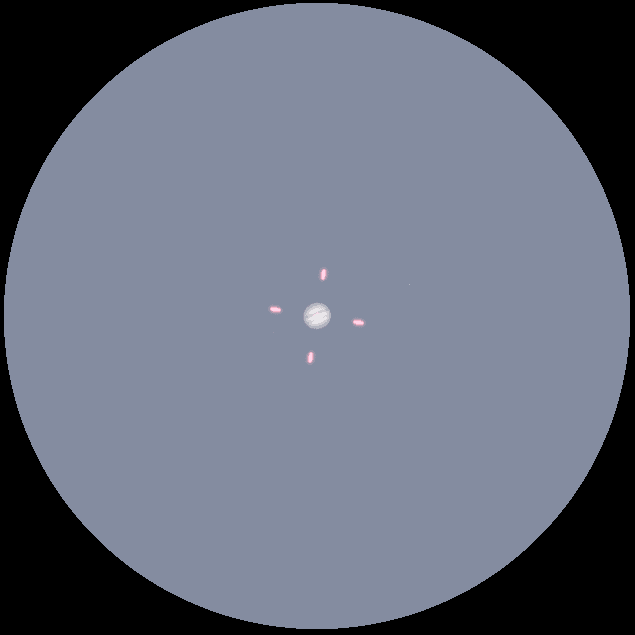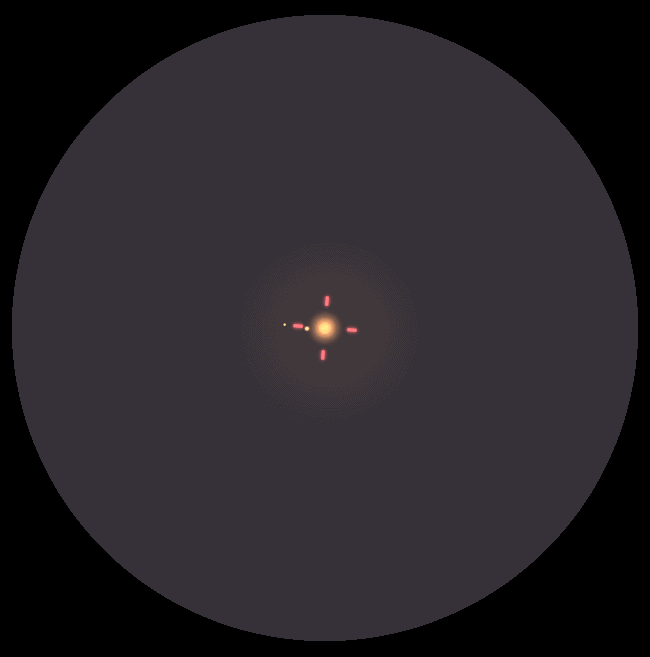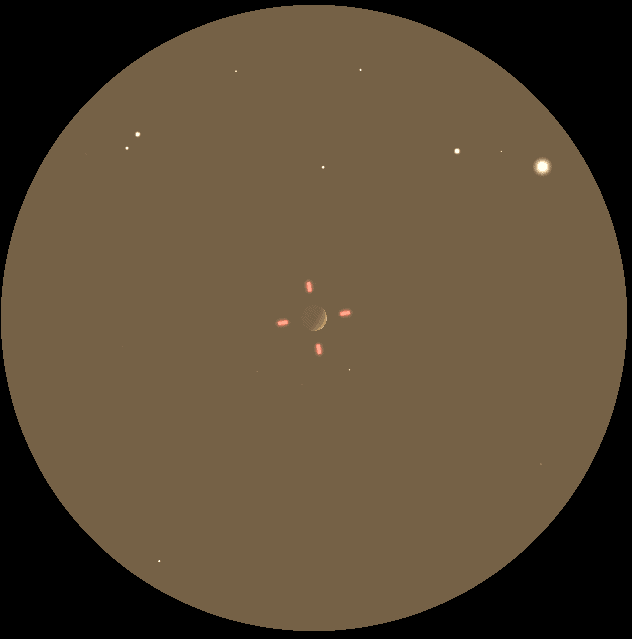What Telescope Do You Need to See Saturn
Chapter DISCLOSURE: I hope you love the products I recommend! Just and so you know, I may collect a share of sales or other compensation from the links on this folio. Cheers very much if you utilize my links, I really appreciate it.
Reading Time: 5 minutes
Magnification is an important cistron when yous plan to notice planets. Non and so much for deep sky objects because most of them are big on the sky; therefore, low magnification is beneficial.
The planets are very small-scale objects to look at, and yous need the highest magnification that your telescope tin can handle to meet the most details. The full general rule is not to get over 200x magnification considering the atmosphere and seeing weather are a limiting factor. Annihilation beyond that will result in a bigger but blurry epitome.
At that place are few things to know about magnification. The highest useful magnification is given by the telescope's aperture, and the usable magnification depends on the seeing conditions at a given fourth dimension.
The Highest Useful Magnification For A Telescope
Every telescope has a magnification limit that is called the highest useful magnification. This limit is calculated using the aperture of the telescope. The aperture of the telescope is basically the diameter of the primary mirror in a Newtonian reflector or the bore of the lens in a refractor telescope.
The easiest way to calculate your telescope's highest useful magnification is to accept your aperture in millimeters and multiply by 2x. Or 50 times the discontinuity of the telescope in inches. Here is a table to help you make up one's mind the highest useful magnification of your telescope.
| Aperture | HIGHEST USEFUL MAGNIFICATION |
| 2″(50mm) | 100x |
| 2.seven″(70mm) | 140x |
| iv″(100mm) | 200x |
| iv.v″(114mm) | 228x |
| 5″(130mm) | 260x |
| half dozen″(150mm) | 300x |
| viii″(200mm) | 400x |
| 10″(250mm) | 500x |
| 12″(300mm) | 600x |
| xiv″(350mm) | 700x |
| xvi″(400mm) | 800x |
As you can see, fifty-fifty with a small telescope, the highest useful magnification is pretty loftier to reach the limits of the seeing weather. In perfect conditions, you lot tin utilise more than 200x magnification, but those situations are rare.
And then what is the indicate in ownership a large aperture when you can't go over 200x? Well, the size of the discontinuity is also the resolving power of the telescope. The planets volition have more details with a 16″ telescope using 200x magnification than a 4″ telescope using the same 200x magnification.
And if you lot plan to image planets, you can go well over the 200x limit considering the procedure of imaging planets is called lucky imaging, where the software is using merely the best frames and stacking them together.
Focal Length And The Eyepiece
The focal length of the telescope and the eyepiece determine the magnification of the telescope. A longer focal length will give y'all more magnification with a given eyepiece.
Ale you accept to do is to divide the focal length of the telescope by the focal length of the eyepiece. Telescope with a focal length of 1000mm and eyepiece with 10mm focal length will provide 100x magnification.
To learn more than about magnification, read my article on How To Increase The Magnification Of The Telescope.
The All-time Seeing Conditions For Loftier Magnification
Atmospheric conditions are responsible for fifty% of success for image quality in your eyepiece. So, it is essential to plan your observing session based on that.
The first affair to look for is clear skies, obviously, and the other 1 is atmospheric turbulence. Atmospheric turbulence is small-calibration, irregular air motions in the atmosphere. It is like looking through the water. This is why stars twinkle in the nighttime sky.
In that location are two things to look for when planing the observing session. Starting time, ever look for loftier-pressure systems over your area. These are the best conditions to detect planets.
And 2nd, the Jet Stream, which is your biggest enemy. If y'all see a Jet Stream over your area, don't fifty-fifty bother taking out your telescope unless you have a very limited number of clear nights during the twelvemonth. The jet stream is a fast-flowing, narrow, meandering air current. Very bad for using a telescope on planets. You should always check Jet Stream Live Map.
What Magnification Practise You Need To Run into Jupiter?

Jupiter is best to view at 200x magnification or less. It is a very depression dissimilarity planet, and high magnification results in less contrast.
Going over 200x magnification will make information technology worse, big and blurry. Jupiter is the largest planet in our solar arrangement, so you can get away with lower magnification to relish cloud bands or the big cerise spot.
What Magnification Exercise You Need To See Saturn?

Saturn is the second-largest planet in our solar arrangement, and then information technology is too piece of cake to see even with smaller telescopes. You can use 200x magnification and maybe 250x magnification if the seeing atmospheric condition allow that.
To meet more details on the Saturn rings, you can push button it fifty-fifty higher over 250x magnification. Saturn is the most beautiful planet to look at, in my opinion, and it will blow your mind to run across it the first time in the eyepiece.
What Magnification Do You Need To Run across Mars?

Mars is pretty small in the heaven, so the best do is to employ the telescope's highest useful magnification.
The goal here is to make information technology bigger because yous will not be able to see many surface details otherwise. You tin use 200x magnification or even more based on your seeing conditions.
What About The Rest Of The Solar System?

Venus is a beautiful planet to look at because you tin can find the crescent phases irresolute while it is orbiting the Sun. Yous can apply 200x magnification or more considering there are no surface details to look at.
Mercury is as well prissy to look at especially watching the crescent phases and some surface details. Y'all tin can use 200-250x magnification.
The rest of the planets like Uranus, Neptune, and Pluto(yes, I said it, Pluto is a Planet:)) are non extremely exciting in the eyepiece, fifty-fifty with actress high magnifications. They are likewise far abroad to run into whatever details considering they volition ever exist simply pocket-size dots in the telescope.
Few Tips For Best Image Quality With High Magnification
Y'all can view planets in depression magnification and bask information technology, but to go the best prototype with the highest useful magnification, I want to give you a few more tips.
Planets In Opposition
The best fourth dimension to observe planets is when they are in opposition. What does it mean? If the planet is in opposition, it is closest to us hence the biggest in the sky.
Check this "Planet Calendar" for dates when are the planets in opposition.
Collimation
If y'all are using a Newtonian reflector telescope or any other designusing mirrors to produce the image, you demand perfect collimation. Collimation is basically the mirrors' alignment, and without that, the paradigm is blurry in the eyepiece.
Near people complaining virtually their telescopes says that the paradigm quality is poor even when using small magnification, but the problem is that their telescopes are out of collimation.
Thermal Equilibrium
Another issue people have is thermal equilibrium. The story goes similar this: you check the weather, jet stream, and everything is perfect. You take out your telescope, but you come across a lot of baloney and turbulence through the eyepiece.
The problem is that your telescope has non reached the ambient temperature outside, and the hot air from the telescope itself is distorting the image.
That's why yous always have to fix the telescope before and take it out in accelerate to acclimatize to ambient temperature. How long it takes depends on the aperture of the telescope. The bigger the discontinuity, the longer it takes to acclimatize.
The Best Telescope To Run into Planets
With all that said, you may be asking now what telescope is the best to apply for planets?
If we take everything that we learned in this commodity, nosotros need a telescope with an aperture big plenty to encounter the most details and accept proficient resolving power. The 2d criterion is to have a long focal length to achieve loftier magnifications easily with the eyepiece.
The most suitable candidate for the best telescope to see planets is the Schmidt-Cassegrain telescope. These telescopes have a long focal length in a small package, so they are easy to use and are portable to take anywhere.
An example of the best telescope for planets is Celestron NexStar Evolution 8″ Schmidt-Cassegrain.

This telescope has an 8″(200mm) discontinuity with the highest useful magnification of 400x. This telescope's focal length is 2032mm, which makes it like shooting fish in a barrel to reach loftier magnifications.
Information technology is mounted on a computerized mount, which is also important considering keeping the planet in the eyepiece'southward field of view using loftier magnifications is a tricky chore. Even the slightest touch or movement of the telescope will crusade a planet to disappear from the field of view. This telescope will do information technology for yous because it tin track the object in the sky and keep it in the eyepiece for hours.
Here are some of my favorite gear
Thanks for reading this commodity. I hope you plant it helpful every bit you learn more most telescopes. Here are some of the gear I use and recommend.
Beginner telescope: This is past far the all-time beginner telescope you can buy. The Orion SkyQuest XT6 is the perfect telescope to showtime with. The aperture is big enough to see nigh every object in the nighttime sky and on the other hand, the cost is so low for what this telescope tin can exercise.
My astrophotography telescope: I use only a newtonian telescope to do astrophotography. I use an viii" newtonian astrograph telescope.
If you want more recommendations delight cheque my recommended gear section.
Source: https://telescopeguides.com/what-magnification-do-you-need-to-see-planets/
Post a Comment for "What Telescope Do You Need to See Saturn"